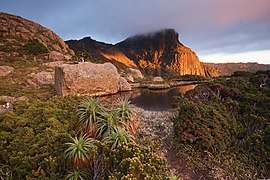Plant community
A plant community (sometimes "phytocoenosis" or "phytocenosis") is a collection or association[1] of plant species within a designated geographical unit, which forms a relatively uniform patch, distinguishable from neighboring patches of different vegetation types. The components of each plant community are influenced by soil type, topography, climate and human disturbance. In many cases there are several soil types within a given plant community.[2]

Definition
A plant community can be described floristically (the species it contains) and/or phytophysiognomically (its physical structure). For example, a forest (a community of trees) includes the overstory, or upper tree layer of the canopy, as well as the understory, further subdivided into the shrub layer, herbaceous layer, and sometimes also moss layer. In some cases of complex forests there is also a well-defined lower tree layer. A plant community is similar in concept to a vegetation type, with the former having more of an emphasis on the ecological association of species within it, and the latter on overall appearance by which it is readily recognized by a layperson.
A plant community can be rare even if none of the major species defining it are rare.[1]:115 This is because it is the association of species and relationship to their environment that may be rare.[1]:115 An example is the Sycamore Alluvial Woodland in California dominated by the California sycamore Platanus racemosa.[1]:115 The community is rare, being localized to a small area of California and existing nowhere else, yet the California sycamore is not a rare tree in California.[1]:115
Examples
An example is a grassland on the northern Caucasus Steppes, where common grass species found are Festuca sulcata and Poa bulbosa. A common sedge in this grassland phytocoenosis is Carex shreberi. Other representative forbs occurring in these steppe grasslands are Artemisia austriaca and Polygonum aviculare.[3]
An example of a three tiered plant community is in Central Westland of South Island, New Zealand. These forests are the most extensive continuous reaches of podocarp/broadleaf forests in that country. The overstory includes miro, rimu and mountain totara. The mid-story includes tree ferns such as Cyathea smithii and Dicksonia squarrosa, whilst the lowest tier and epiphytic associates include Asplenium polyodon, Tmesipteris tannensis, Astelia solandri and Lomaria discolor.[4]
See also
- Community (ecology)
- Size-asymmetric competition
- Ecosystem
- Habitat
- Phytosociology
- Stand level modelling
References
- Introduction to California Plant Life, Robert Ornduff, Phyllis M. Faber, Todd Keeler-Wolf, California Natural History Guides No. 69, University of California Press, Ltd., 2003, ISBN 978-0-520-23704-9
- Jean-Michel Gobat, Michel Aragno, Willy Matthey and V. A. K. Sarma. And Watermelon. 2004. The living soil
- J.M. Suttie, Stephen G. Reynolds and Caterina Batello. 2005. Grasslands of the world, Food and Agriculture Organization of the United Nations, 514 pages
- C. Michael Hogan. 2009. Crown Fern: Blechnum discolor, Globaltwitcher.com, ed. N. Stromberg